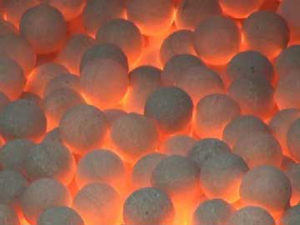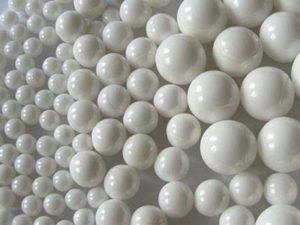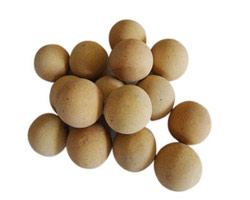In the world of industrial manufacturing, maximizing thermal efficiency is key to maintaining productivity and profitability. One way that companies achieve this is by using high alumina refractory balls. These small but mighty balls are an essential component in many high-temperature processes, from steel manufacturing to petrochemical refining.
How do high alumina refractory balls improve thermal efficiency in industrial applications?
So, how exactly do high alumina refractory balls improve thermal efficiency in industrial applications? Let’s take a closer look.

Firstly, high alumina refractory balls have excellent thermal insulation properties. Their high alumina content, typically above 90%, means they have a low thermal conductivity. This means they are able to retain heat and prevent heat loss, which is particularly important in high-temperature processes where energy efficiency is critical.
Secondly, high alumina refractory balls are extremely durable. They can withstand temperatures up to 1800°C without any significant deterioration, making them an ideal choice for use in furnaces, kilns, and other high-temperature applications. Their durability means they require less frequent replacement than other refractory materials, resulting in reduced downtime and maintenance costs.
Furthermore, high alumina refractory balls have excellent chemical resistance. They are able to withstand exposure to harsh chemicals, acids, and alkalis without any significant degradation. This makes them particularly useful in industries such as petrochemical refining, where exposure to corrosive substances is common.
Finally, high alumina refractory balls are able to promote thermal uniformity. They are able to distribute heat evenly, reducing hot spots and ensuring that heat is transferred evenly throughout the process. This helps to reduce thermal stress and minimize the risk of damage to equipment, ultimately resulting in improved safety and efficiency.
In conclusion, high alumina refractory balls are a crucial component in many industrial applications, particularly those involving high-temperature processes. They improve thermal efficiency by providing excellent insulation, durability, chemical resistance, and thermal uniformity. By utilizing these powerful little balls, companies are able to achieve optimal productivity and profitability, while also reducing their environmental impact by using less energy and producing fewer emissions.
What are high alumina ceramic balls?
High alumina ceramic balls are small spherical objects made from a high-purity alumina ceramic material. They are typically used as a type of advanced ceramic material in a variety of industrial applications that require high-temperature resistance, wear resistance, and chemical resistance.
High alumina ceramic balls are produced by processing high-purity alumina powder through several stages, including mixing, molding, sintering, and grinding. The sintering process involves heating the molded ceramic balls at high temperatures, which causes the individual alumina particles to fuse together, resulting in a dense and uniform material with excellent mechanical properties.

One of the primary benefits of high alumina ceramic balls is their high-temperature resistance. They can withstand temperatures up to 1800°C without any significant deterioration, making them an ideal material for use in high-temperature processes such as furnace linings, kiln linings, and catalyst support materials.
Another advantage of high alumina ceramic balls is their wear resistance. They are able to withstand repeated impacts and abrasion without any significant degradation, which makes them useful in a variety of wear applications such as grinding media, wear-resistant linings, and ball bearings.
In addition, high alumina ceramic balls exhibit excellent chemical resistance. They are able to withstand exposure to harsh chemicals, acids, and alkalis without any significant degradation, making them useful in a variety of chemical processing applications.
Overall, high alumina ceramic balls are versatile and high-performance advanced ceramic materials that offer excellent thermal, mechanical, and chemical properties. They are widely used in a variety of industrial applications that require high-temperature resistance, wear resistance, and chemical resistance.
High alumina refractory balls vs. high alumina ceramic balls
High alumina refractory balls and high alumina ceramic balls are both made from high-purity alumina materials, but they have different properties and are used for different applications.

High alumina refractory balls are typically used as a type of refractory material in high-temperature industrial applications such as furnaces and kilns. They are designed to withstand high temperatures up to 1800°C without any significant deterioration and have excellent thermal insulation properties due to their low thermal conductivity. High alumina refractory balls are also highly durable and have excellent chemical resistance, making them ideal for use in harsh chemical environments.
On the other hand, high alumina ceramic balls are used for a variety of industrial applications such as grinding media, wear-resistant linings, and ball bearings. They have excellent wear resistance and can withstand repeated impacts and abrasion without any significant degradation. High alumina ceramic balls also have high hardness and high strength, making them suitable for use in high-stress applications.
While both high alumina refractory balls and high alumina ceramic balls are made from high-purity alumina materials and offer excellent properties, they are designed for different applications. High alumina refractory balls are used for high-temperature industrial applications where thermal insulation and chemical resistance are important, while high alumina ceramic balls are used for wear-resistant and high-stress applications such as grinding media and ball bearings.
In summary, high alumina refractory balls and high alumina ceramic balls are both useful advanced ceramic materials that offer unique properties for different applications. It’s important to choose the right material for the specific application to ensure optimal performance and durability.

